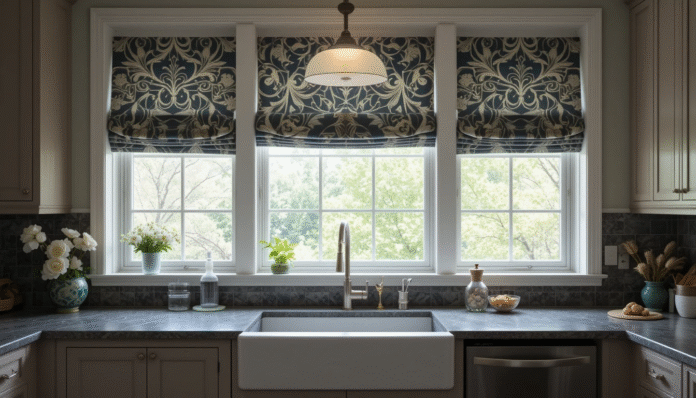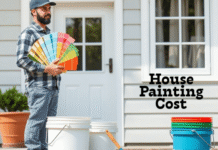Table of Contents
Introduction
When it comes to kitchen window treatments that balance beauty, practicality, and versatility, Roman shades for the kitchen offer an unmatched combination. These soft fabric shades add elegance to your culinary space and provide essential functions such as light filtering, privacy control, and insulation.
Selecting the appropriate window treatments for kitchen décor can significantly improve the room’s overall appearance and use. Roman shades are an excellent choice for kitchens, offering a blend of style, versatility, and practicality.
Whether you prefer a classic look or a modern aesthetic, Roman shades can be customized to suit any design preference. In this comprehensive guide, we’ll explore the various styles, fabric types, and design tips to help you select the perfect Roman shades for your kitchen windows.
| Roman Shade Style | Recommended Fabrics | Light Control | Privacy Level | Best Kitchen Placement |
| Flat Roman Shades | Cotton, linen, polyester | Moderate to high | Moderate | Large kitchen windows or above the sink |
| Relaxed Roman Shades | Linen, silk blends, light cotton | Low to moderate | Low to moderate | Informal kitchen corners or breakfast nooks |
| Hobbled Roman Shades | Heavy cotton, blends, linen | High | High | Main kitchen windows, privacy areas |
| Pleated Roman Shades | Polyester-cotton blend, canvas | Moderate | Moderate | Contemporary kitchen windows |
| Blackout Roman Shades | Lined polyester or heavy cotton | Maximum | Maximum | Kitchens facing direct sunlight |
| Sheer Roman Shades | Voile, sheer linen, polyester | Low | Low | Kitchens with scenic outdoor views |
What Are Roman Shades?
Roman shades are fabric window coverings that stack up evenly when raised and lie flat when lowered. Unlike traditional blinds, they have no slats, which gives them a cleaner, more seamless appearance. Available in various fabrics, colors, and styles, Roman shades work well in traditional and contemporary kitchens.
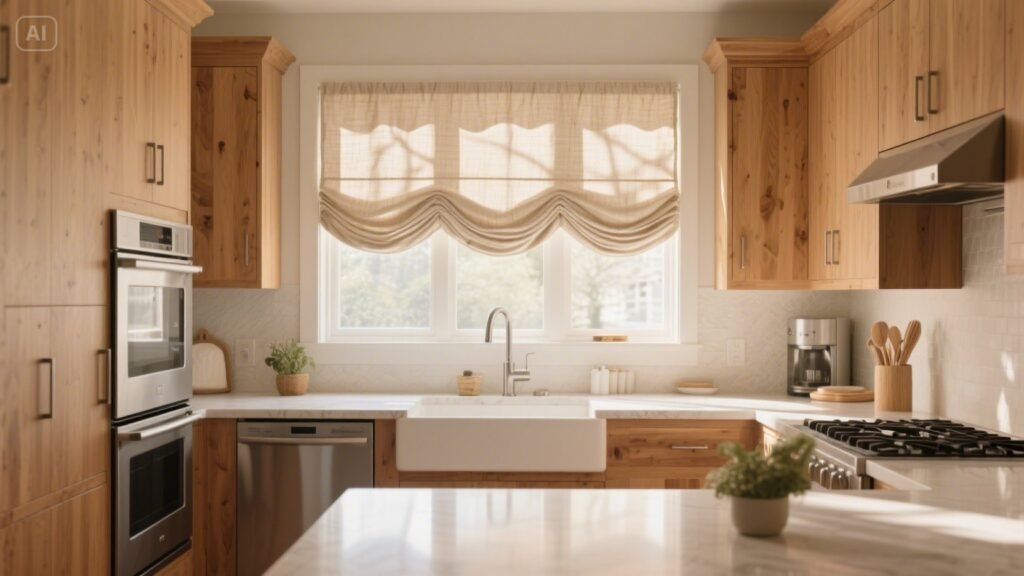
Why Roman Shades Are Ideal for the Kitchen
- Aesthetic Appeal: Roman shades add a soft, tailored look to kitchen windows.
- Functionality: They provide excellent light and privacy control.
- Customizability: Options for lining, mounting, and operating systems allow full personalization.
- Space Efficiency: Ideal for kitchens with limited space where bulky drapes aren’t practical.
Types of Roman Shades for the Kitchen
Choosing the right style of Roman shade is essential to match your kitchen’s overall theme and practical needs.
1. Flat Roman Shades
These shades have a clean, seamless look when lowered and stack neatly when raised. Ideal for showcasing patterned fabrics.
2. Relaxed Roman Shades
When lowered, these shades create a casual, soft curve at the bottom, perfect for cozy or cottage-style kitchens.
3. Hobbled (Looped) Roman Shades
These shades have cascading folds that remain visible even when fully extended, adding depth and texture.
4. Balloon Roman Shades
Featuring billowy folds, balloon shades offer a more decorative, traditional appearance. It is less common in kitchens but effective in vintage or farmhouse designs.
5. Austrian Roman Shades
Similar to balloon shades, these use more fabric and decorative elements. Best used in formal dining kitchens.
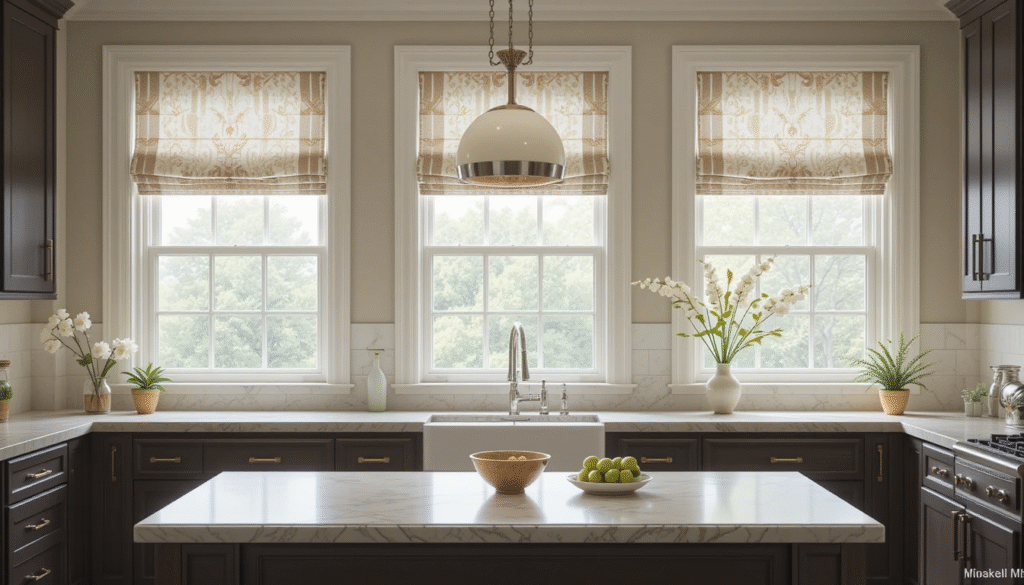
Choosing the Right Fabric for Roman Shades
The fabric you choose will significantly influence the shade’s appearance, durability, and light filtration.
Best Fabrics for Kitchen Roman Shades:
- Cotton and Cotton Blends: Lightweight, breathable, and easy to clean.
- Linen: Offers a textured, organic feel and diffuses light beautifully.
- Polyester: Durable and moisture-resistant, ideal for kitchens with high humidity.
- Silk: Elegant but less suitable for kitchens due to maintenance challenges.
- Performance Fabrics: Treated for stain resistance and UV protection, excellent for high-use areas.
Light Control and Privacy Options
Roman shades offer different levels of light filtering, depending on the fabric and lining.
| Lining Type | Light Control | Privacy Level | Best Use Case |
| Unlined | Soft light diffusion | Low to moderate | Decorative or low-privacy areas |
| Light-filtering lining | Moderate light block | Moderate | Kitchens needing ambient light |
| Blackout lining | High light block | Maximum | Kitchen with bright sunlight |
| Thermal lining | Insulation + privacy | Moderate to high | Energy-efficient kitchens |
Mounting Options: Inside vs. Outside Mount
Choosing between inside and outside mount affects the look and functionality of your Roman shades.
- Inside Mount: Installed within the window frame for a clean, built-in appearance. Best for minimalist kitchens.
- Outside Mount: Mounted above or outside the frame to make windows appear larger and block more light.
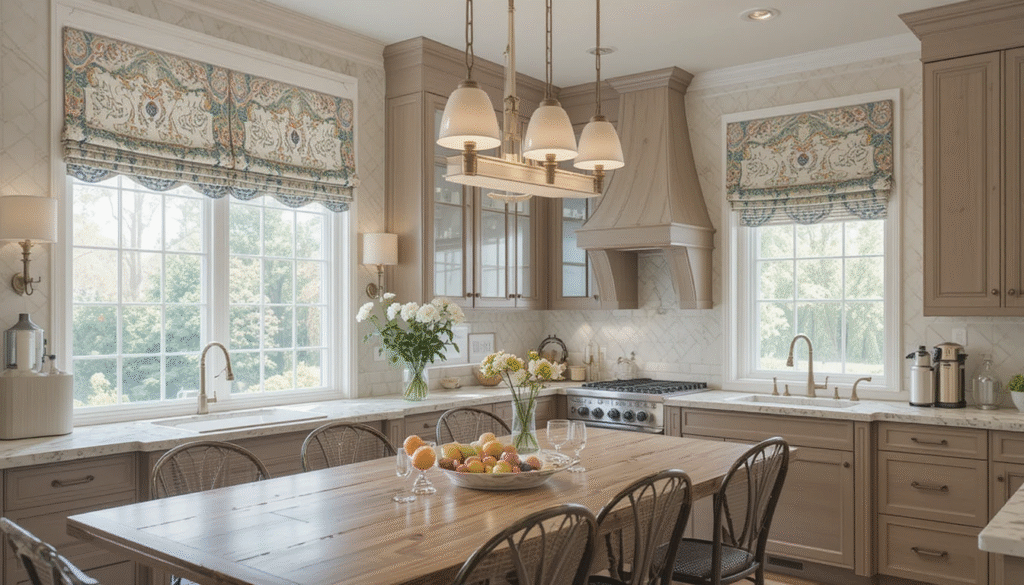
Operation Mechanisms
- Corded: Traditional but less safe for homes with children.
- Cordless: Sleek, modern, and child-safe.
- Motorized: Remote or app-controlled; perfect for hard-to-reach windows.
How to Choose Roman Shades Based on Kitchen Style
Different kitchen designs necessitate various Roman shade styles and materials to achieve the desired aesthetic. In modern kitchens, opt for flat or motorized Roman shades in solid colors or subtle patterns, utilizing polyester or performance fabrics for easy maintenance.
For traditional kitchens, hobbled or balloon styles made from heavier fabrics are ideal, with floral or damask prints enhancing the classic appeal. In farmhouse kitchens, relaxed Roman shades in linen or cotton work well, complemented by earthy tones and muted colors that blend seamlessly with the rustic charm.
Lastly, stick to flat Roman shades in neutral shades for minimalist kitchens and consider cordless or motorized options to maintain a sleek and uncluttered look. Each approach ensures Roman shades align beautifully with your kitchen’s overall design.
Maintenance Tips for Kitchen Roman Shades
- Regular Dusting: Use a handheld vacuum or soft brush.
- Spot Cleaning: Use a mild soap solution and dab gently.
- Professional Cleaning: For delicate or heavily stained fabrics.
- Avoid Excessive Moisture: Keep shades away from splash zones or choose moisture-resistant materials.
Budget Considerations
The cost of Roman shades for the kitchen can vary based on material, size, custom features, and motorization.
- Basic Cotton Shades: $50–$100 per window
- Custom Shades with Lining: $150–$300
- Motorized Roman Shades: $300–$600 per unit
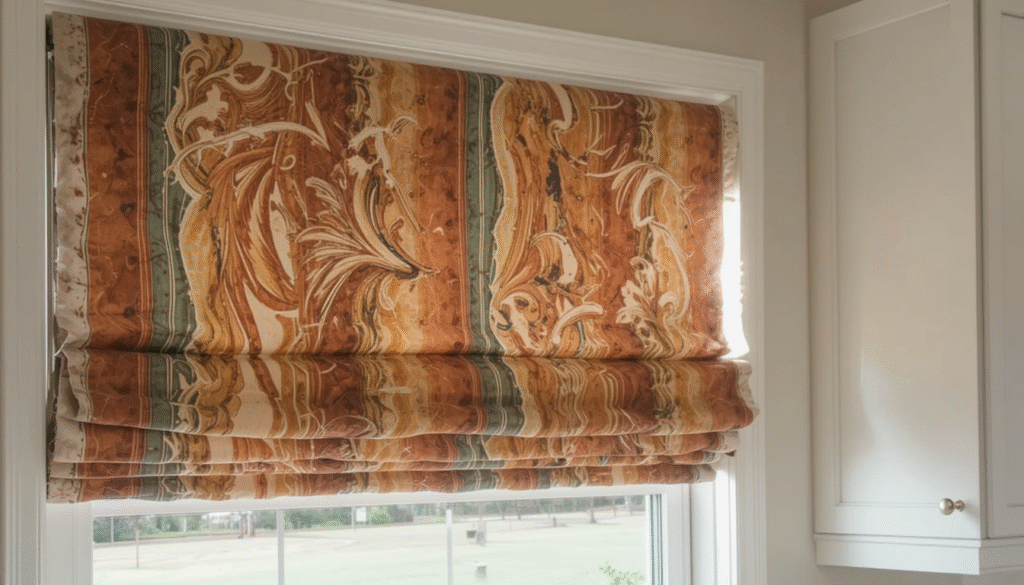
Sustainability and Eco-Friendly Choices
Opt for:
- Organic fabrics like cotton or bamboo.
- Recycled materials for an eco-conscious kitchen.
- Energy-efficient linings to reduce heating/cooling costs.
Final Thoughts
Roman shades for the kitchen are not just a decorative element—they offer a practical and stylish solution to control light, preserve privacy, and complement your kitchen’s overall design. From fabric choices to operating mechanisms and custom designs, these shades provide versatility and elegance in equal measure.
Whether updating a modern kitchen or adding charm to a rustic space, Roman shades can elevate your windows beautifully and functionally.
Want to know about ‘Blue Kitchen Backsplash Design Ideas That Blend Beauty, Function, and Modern Elegance‘? Check out our ‘Home Improvement‘ category.
FAQs
Flat or relaxed Roman shades are ideal for small kitchen windows. They provide a clean look without overwhelming the space and are easy to operate in tighter areas.
Polyester, poly-cotton blends, or treated cotton fabrics are best for high-moisture zones near sinks or stoves. These materials are easier to clean and more resistant to moisture and mildew.
Yes. Roman shades made with thicker fabrics or lined with blackout or thermal material can help regulate indoor temperatures by blocking excess sunlight and insulating the window area.
Most Roman shades are relatively easy to maintain. Choose machine-washable or wipeable fabrics for easier cleaning, especially in areas prone to grease or splashes.














